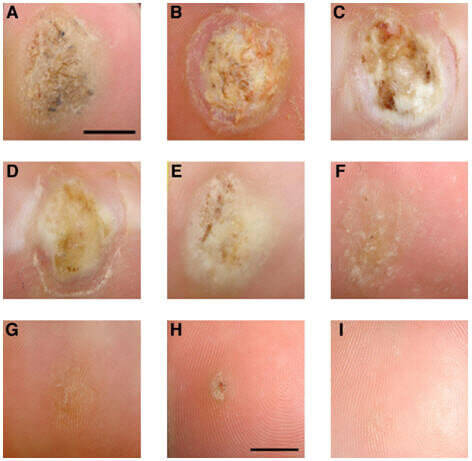Comprehensive Guide to Understanding and Managing Plantar Warts
Plantar warts are a common foot condition caused by the Human Papillomavirus (HPV) entering through cuts or breaks in the skin on the soles of the feet. Recognizable by their hard, grainy appearance, often on the heels or balls of the feet, plantar warts can be a source of discomfort and pain. While generally benign, their removal is frequently sought for relief and cosmetic reasons.
Understanding the intricacies of their causes and recognizing their symptoms are pivotal steps in managing and seeking appropriate treatment for these growths. Here’s a deeper look into what causes plantar warts and the symptoms that accompany them.

Causes of Plantar Warts
HPV Infection: The primary cause of plantar warts is the HPV virus. While many strains of HPV exist, only a few tend to cause warts on the feet. This virus is particularly adept at entering the skin through small cuts, breaks, or weak spots on the soles of the feet. Once the virus infiltrates the outer layer of the skin, it prompts rapid cell growth, leading to the formation of warts.
Transmission: HPV thrives in warm, moist environments, making public pools, showers, and locker rooms hotspots for transmission. The virus can spread through direct contact with infected skin or by contact with surfaces contaminated with the virus. Walking barefoot in such areas significantly increases the risk of acquiring plantar warts.
Individual Susceptibility: Not everyone who comes into contact with HPV will develop plantar warts. Factors such as immune system strength and the integrity of the skin on the feet influence susceptibility. Those with weakened immune systems or existing cuts and abrasions on their feet are more likely to develop warts.
Symptoms of Plantar Warts
Appearance: Plantar warts are distinguished by their rough, grainy texture and are often gray or brown. They may appear as flat lesions or slightly raised bumps on the sole, commonly on the heel or ball.
Pain and Discomfort: One of the hallmark symptoms of plantar warts is discomfort or pain when standing or walking, akin to feeling a pebble in one’s shoe. This sensation results from the pressure applied to the wart by body weight.
Callused Surface: Plantar warts can become covered with a layer of callus as the body attempts to protect the area, making them less visible but still palpable due to the underlying lump.
Pinpoint Bleeding: Distinctive tiny black dots, often called wart seeds (which are clotted blood vessels), can be visible on the surface of the wart. These can become more apparent if the wart is pared down.
Change in Footprint: Individuals with plantar warts may notice alterations in their footprint pattern due to the change in pressure distribution as they try to avoid pain while walking.
Understanding these causes and symptoms not only aids in early detection but also emphasizes the importance of preventive measures, such as wearing protective footwear in communal wet areas and maintaining good foot hygiene. For those experiencing symptoms of plantar warts, particularly if they persist or cause significant discomfort, consulting a healthcare professional or podiatrist is advisable to explore appropriate treatment options.
When to See a Podiatrist
Consultation with a podiatrist is recommended if plantar warts cause significant pain, affect mobility, or persist despite home treatment. Individuals with diabetes or immune system disorders should seek immediate medical attention to avoid complications.
Diagnosis and Treatment Options
Diagnosis: A podiatrist can typically diagnose plantar warts by examining the foot. In some cases, a small sample of the wart may be removed to expose tiny clotted blood vessels or to conduct a biopsy for a definitive diagnosis.
Professional Treatments: Several methods are available for removing plantar warts, including:
- Cryotherapy: Freezing the wart with liquid nitrogen.
- Electrosurgery and Curettage: Removing the wart with electric needles followed by scraping.
- Laser Treatment: Using lasers to burn and destroy wart tissue.
- Topical Treatments: Prescription creams or solutions that gradually peel away the wart.
Home Remedies and Prevention
Apple Cider Vinegar Soak: Anecdotal evidence suggests that soaking the affected foot in apple cider vinegar may help diminish plantar warts. Following the soak, use a pumice stone to gently remove dead skin, and keep the area covered between treatments.
Preventive Measures: To reduce the risk of developing plantar warts, avoid walking barefoot in public areas, especially if you have open wounds on your feet. Maintaining good foot hygiene and wearing protective footwear in communal wet areas can significantly decrease the chance of HPV infection.
Say Goodbye to Plantar Warts Today!
Don’t let plantar warts keep you from enjoying life to the fullest. Our experienced podiatrists at Austin Foot & Ankle Center specialize in effective treatments for plantar warts, helping you regain comfort and confidence in your steps.
If you’re tired of dealing with the pain and inconvenience of plantar warts, take action now. Schedule a consultation with our expert team to explore your treatment options and say goodbye to plantar warts for good.
Contact Austin Foot & Ankle Center today to take the first step towards clear, healthy feet.

